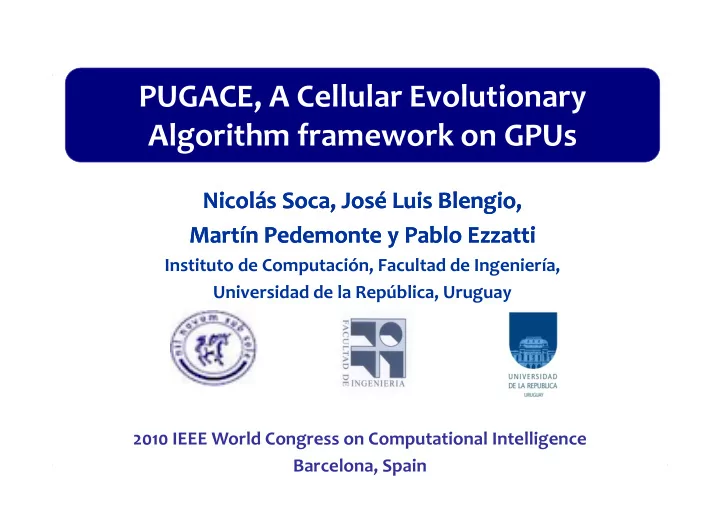

PUGACE, A Cellular Evolutionary Algorithm framework on GPUs Nicolás Soca, José Luis Blengio, Nicolás Soca, José Luis Blengio, Martín Pedemonte Martín Pedemonte y Pablo Ezzatti y Pablo Ezzatti Instituto de Computación, Facultad de Ingeniería, Instituto de Computación, Facultad de Ingeniería, Universidad de la República, Uruguay 2010 IEEE World Congress on Computational Intelligence Barcelona, Spain PUGACE, A Cellular Evolutionary Algorithm framework on GPUs
Outline Outline • Motivation & Objectives • Graphic processing units • Cellular Evolutionary Algorithms • Related work • PUGACE • PUGACE • Experimental results • Conclusions and future work PUGACE, A Cellular Evolutionary Algorithm framework on GPUs
Motivation & Objectives Motivation & Objectives • Parallel Evolutionary Algorithms: – decrease execution time – not only speed up the search: new exploration patterns • Graphic Processing Units (GPUs): – low cost platform for implementing parallel algorithms – complex architecture • Objective: – build a tool for easily developing cellular Evolutionary Algorithms (cEAs) on GPUs PUGACE, A Cellular Evolutionary Algorithm framework on GPUs
Graphic Processing Units Graphic Processing Units • Architecture is intrinsically parallel • Shared memory multi-core processors • Memory hierarchy: – registers – shared block memory – local memory – global memory • Programming tools for general purpose computing: CUDA and OpenCL PUGACE, A Cellular Evolutionary Algorithm framework on GPUs
Cellular Evolutionary Algorithms Cellular Evolutionary Algorithms • Single population structured in many small overlapped neighborhoods • Each individual belongs to several neighborhoods • An individual can only be mated for reproduction with individual of its neighborhood • High-quality solution gradually spreads (diffusion) • High-quality solution gradually spreads (diffusion) PUGACE, A Cellular Evolutionary Algorithm framework on GPUs
Related work Related work • All standard parallel strategies for Evolutionary Computation have already been implemented successfully on GPUs: – master-slave – island model – cellular model • cEAs on GPUs obtained good speedup values • cEAs on GPUs obtained good speedup values • EASEA: – generates code that automatically exploits GPU capabilities – follows a master-slave model for evaluation of the population • No proposals of generic framework PUGACE, A Cellular Evolutionary Algorithm framework on GPUs
PUGACE PUGACE • Generic framework for implementing cEAs on GPUs • Problem related features must be implemented • In line with: Mallba, JCell, ParadisEO, etc. • Implemented in C and CUDA (version 2.1). • Supports different problem encoding, selection policies, crossover operators and mutation operators crossover operators and mutation operators • Supports a local search method • Can be extended to incorporate additional operators PUGACE, A Cellular Evolutionary Algorithm framework on GPUs
PUGACE (2) PUGACE (2) • Design: – extensible: new evolutionary operators and neighborhood structures can be incorporated – easy to use: implementation separated in several modules encapsulating different functionalities (CUDA limitations) functionalities (CUDA limitations) • First version: generality of the design favored over efficiency • GPU aspects not considered in this version: – maximizing the usage of shared block memory – coalescing the access to memory PUGACE, A Cellular Evolutionary Algorithm framework on GPUs
PUGACE (3) PUGACE (3) • Population: – always resided in the device memory – arranged in a circular 1-dimensional structure – individuals from both ends are copied to opposite end • Each individual executes in a different thread (blocks of varying size) • Neighborhood: configurable number of individuals to the left and right • Application of crossover and mutation operator is decided at block level (to avoid thread divergence) • Problem information preloaded on constant memory PUGACE, A Cellular Evolutionary Algorithm framework on GPUs
PUGACE (4) PUGACE (4) • Fitness values are stored in an auxiliary vector • Fitness function evaluation uses an independent thread for each chromosome • Generational replacement: each parent is replaced by the best one of its children • Random numbers could be generated: • Random numbers could be generated: – in the CPU and transferred to GPU in each generation (CPU idle times) – in the GPU with a specific algorithm based on a linear congruential method PUGACE, A Cellular Evolutionary Algorithm framework on GPUs
Experimental results Experimental results • Quadratic Assignment Problem with a simple approach: – permutation representation – proportional selection – partially mapped crossover – mutation operator: randomly swap two values – local search: randomly selects a position and makes the best – local search: randomly selects a position and makes the best exchange between the selected position and the rest • Parameters: – population = 2048, neighborhood length = 4 – thread blocks = 32 – thread per block = 64 • Pentium dual-core 2.5 GHz with 2 GB RAM and a nVidia GeForce 9800 GTX+ PUGACE, A Cellular Evolutionary Algorithm framework on GPUs
Experimental results (2) Experimental results (2) • Best known solution in 13 out of 14 instances • More than 5 Hits in 10 runs for instances with less than 30 facilities • Less than 5 Hits in 10 runs for instances with more than 30 facilities • Acceptable for a simple approach • Acceptable for a simple approach PUGACE, A Cellular Evolutionary Algorithm framework on GPUs
Experimental results (3) Experimental results (3) • Tests performed to evaluate reductions in runtime obtained by implementing a cEA on a GPU rather than on a CPU • Runtime reductions ranged between 15 and 19 • Increase in number of individuals impacts in a sublinear increase in the execution time (10% when doubling the population size) population size) PUGACE, A Cellular Evolutionary Algorithm framework on GPUs
Conclusions and future work Conclusions and future work • Conclusions: – Proposal of a tool for easily implementing cEA on GPUs – High reductions on execution time • Future work: – second version: • coalescing the access to memory • coalescing the access to memory • maximizing the usage of shared block memory • upgrade to CUDA 3.1 – use the framework to solve a concrete problem – new experiments on different devices PUGACE, A Cellular Evolutionary Algorithm framework on GPUs
Thank you for your attention Thank you for your attention PUGACE, A Cellular Evolutionary Algorithm framework on GPUs
Recommend
More recommend